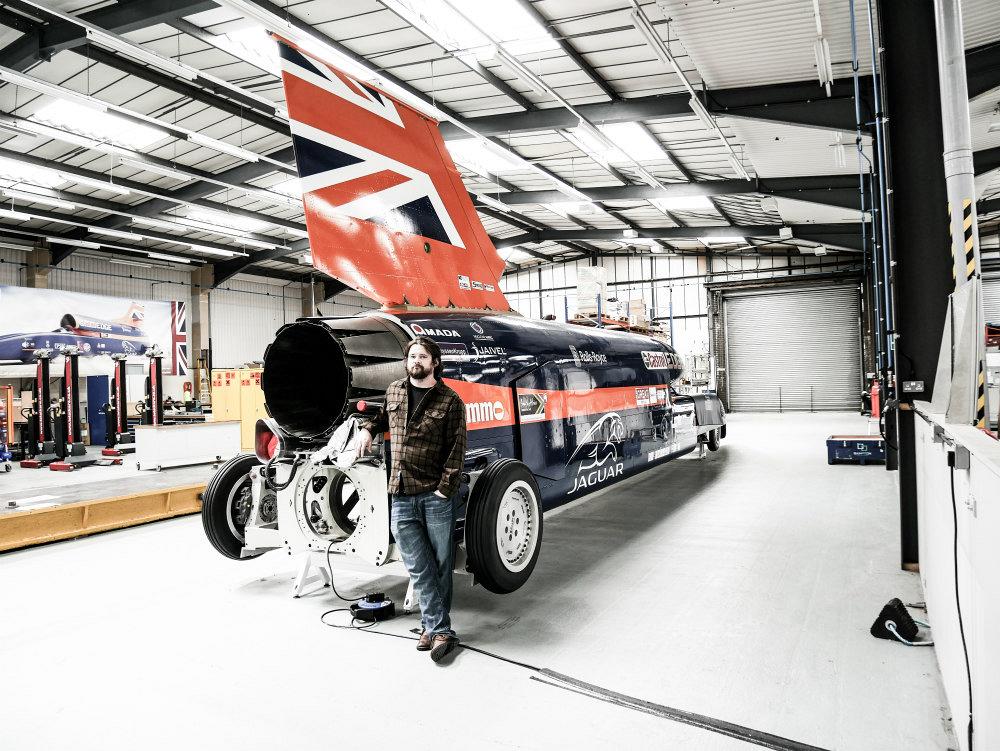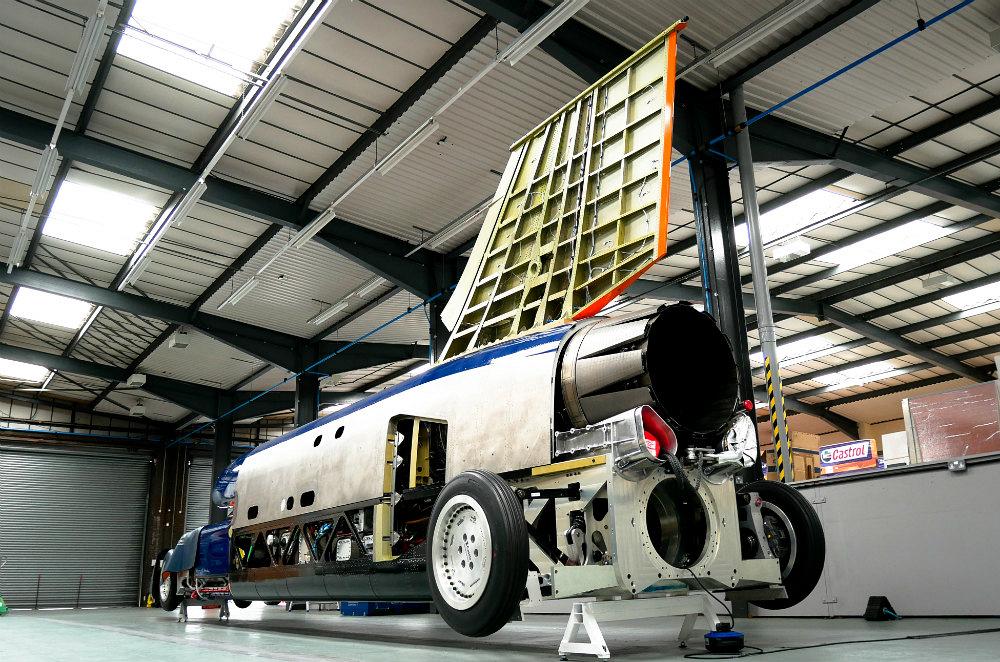Owner, Brown Dog Welding
- FMA
- The Fabricator
- FABTECH
- Canadian Metalworking
Categories
- Additive Manufacturing
- Aluminum Welding
- Arc Welding
- Assembly and Joining
- Automation and Robotics
- Bending and Forming
- Consumables
- Cutting and Weld Prep
- Electric Vehicles
- En Español
- Finishing
- Hydroforming
- Laser Cutting
- Laser Welding
- Machining
- Manufacturing Software
- Materials Handling
- Metals/Materials
- Oxyfuel Cutting
- Plasma Cutting
- Power Tools
- Punching and Other Holemaking
- Roll Forming
- Safety
- Sawing
- Shearing
- Shop Management
- Testing and Measuring
- Tube and Pipe Fabrication
- Tube and Pipe Production
- Waterjet Cutting
Industry Directory
Webcasts
Podcasts
FAB 40
Advertise
Subscribe
Account Login
Search
Time Travel: Part II
The Beast of Turin and the Bloodhound
- By Josh Welton
- May 9, 2017
Read Part I of this series here
.The Federation Internationale de l'Automobile (FIA) requires land-speed record (LSR) cars to have at least four wheels, and two of them must turn. So the Bloodhound SSC has four wheels, and two of them turn. The bay that houses the Bloodhound is equal parts aircraft hangar and hot rod shop. To the left is a small but well-equipped metal fabrication space. Next to that is a long, narrow surface plate, a fixture to build and test the rocket fuel delivery setup (which looks ready to rock) and a parts cage. Right of us sits a gantry crane used to lift off the top half of the car, a trolley with a cradle for quick-changing the rockets, and a jig to build the car’s tail fin.
As it sits, the car is being prepped for testing up to about 200 MPH. This will be done at a local airport in Newquay. Thousands of sensors in every nook and cranny of the chassis, body, and fin will feed data back to the team so they can double-check their predicted calculations before going balls to the wall starting (hopefully) next year.
Tires with rubber wheels and carbon-ceramic brakes are a couple of the items currently on the car that will not make the trip for high-speed runs. The rubber-shod wheels will be replaced by one-piece aluminum discs, a specially forged high-strength alloy called 7037. Rubber tires can’t withstand the 50,000 Gs created at 1,000 MPH. I first thought of the discs almost as skis, but they’re not. They’ll turn at 10,200 RPM when called to duty, which is mostly for stability and helping to maintain direction.
The carbon-ceramic disc brakes are prone to explode at around 500 MPH. They’re OK for low-speed, airport-runway testing, but old-school steel discs get tasked with bringing the Bloodhound down to a complete standstill when it goes all out in the desert.
Accurate stopping is important. To break an LSR, you need to back up your run with another within an hour. Parachutes and airbrakes will get you in the vicinity (via a combined 20 tons of drag), but disc brakes allow the Bloodhound to stop on a dime in its "pit" area. Playing into this second run are the aforementioned gantry, trolley/cradle, and jig. They're all designed for speed and efficiency when in the hands of the crew.
The cradle is especially critical, as each maximum effort run requires a new rocket. Rocket builder Nammo is very excited about future benefits to space travel from this quick-change system in which the used piece is slid out and the new rocket is slid in.
Great lengths have been taken to ensure driver Andy Green comes out of this experience in one piece. The streamlined body’s titanium skin is both riveted and glued to the frame, a frame that is machined from billet aluminum. When adrenaline and G-forces saturate your body as you blast into and through triple-digit speeds, hands can grip with superhuman force. The steering wheel is superlight and superstrong 3-D-printed titanium.
There’s a 30-minute supply of fresh air to Andy’s mask in the event he’s trapped in the cockpit. Both the twin parachutes and airbrakes are deployed via giant, mechanical levers: one for each chute on the left, and a third for the airbrakes on the right.
Andy’s driving compartment has been designed for him specifically, sized to fit like a glove. The monocoque he lies inside of is built of layers upon layers of different types of carbon fiber, aluminum, and even ballistic armor. A stone kicked up at the speed of sound might as well be a blast from a .45. The windscreen is a specially developed acrylic masterpiece about an inch thick, thicker than that on a fighter jet.
The car is a hybrid; the Bloodhound has both the sophisticated turbofan heart of a Eurofighter Typhoon and a rocket specifically developed and built for this mission, a joint venture from Bloodhound and Nammo. When the two power plants are engaged together, they’re good for about 135,000 HP.
During low-speed testing (under 600 MPH), it’ll need only the jet engine. The turbofan was built specifically for the Typhoon fighter, and the entire package has been a difficult swap for the car. This includes an array of sensors that are supposed to be measuring flight conditions, not ground conditions. A pitot-static sensor (the probe that looks like a lightning rod on the front of supersonic jets) is up on the fin, and it captures air speed and air pressure data crucial to the turbofan's proper function. The Bloodhound engineers have learned to trick the EJ200’s touchy operating system into thinking it’s A-OK to fire off while at an elevation of 4 feet.
The fin is a piece that looks simple in finished form, but underneath is a mess of cameras, gauges, and sensors, along with a puzzle of aluminum struts and spars snapped together precisely with a laser-aligned jig. An RAF squadron of engineers has taken responsibility for this section, as it is very much like the tail sections of fighter jets they work with daily. The fin’s most important task is keeping the Bloodhound straight. The team likens it to feathers on an arrow—a long, narrow “shaft” in flight with aim kept true by those feather fins.
Early in the project a 2.4-l 750-HP Cosworth F1 engine turned the fuel pump. The pump, which is based on a piece that did the same job in a 1960s cruise missile, feeds 210 gallons of high-test peroxide to the rocket in 20 seconds (an APU connected to the EJ200 powers the electronics and hydraulics).
When I heard Jaguar came onboard and the new auxiliary power unit was basically the same 550-HP supercharged mill found in their F-Type, my first thought was that they compromised performance for a new sponsor. But that wasn’t the case.
The F1 engine required a lengthy warm-up time and pretty much had to be torn down and inspected after every run. A team of F1 mechanics had to follow the Bloodhound, and only they were allowed to touch the “black box” controls. The secrecy flew in the face of the “open-door” educational foundation the Bloodhound SSC project stands on.
Some preparation has already taken place at HakskeenPan in South Africa. The Project hired 300 locals to clear debris from the 12-mile track they carefully laid out. Work has already been performed at the site, including a test where Andy drove an F-Type R all out towards an oncoming L39 Albatross fighter to prove out their communication system at the equivalent of quadruple-digit speeds.
Runway testing for the car is expected to commence this year. Due to funding issues, the Bloodhound SSC project has faced some delays, but the goal is still the same. As of right now they expect to make a run towards 800 MPH next October, and if all goes well, they’ll shoot for 1,000 MPH in 2018.
While there are obvious differences, the Beast of Turin and the Bloodhound SSC both share a passion—both were designed and engineered to be the fastest wheeled vehicle anywhere on earth. A century, and yet somehow just an afternoon, apart.
All photos courtesy of Josh Welton, Brown Dog Welding. The photos in this slideshow are predominately of the Bloodhound. Part I features photos of the Beast of Turin.
subscribe now

The Welder, formerly known as Practical Welding Today, is a showcase of the real people who make the products we use and work with every day. This magazine has served the welding community in North America well for more than 20 years.
start your free subscriptionAbout the Author

About the Publication
- Stay connected from anywhere

Easily access valuable industry resources now with full access to the digital edition of The Fabricator.

Easily access valuable industry resources now with full access to the digital edition of The Welder.

Easily access valuable industry resources now with full access to the digital edition of The Tube and Pipe Journal.
- Podcasting
- Podcast:
- The Fabricator Podcast
- Published:
- 04/16/2024
- Running Time:
- 63:29
In this episode of The Fabricator Podcast, Caleb Chamberlain, co-founder and CEO of OSH Cut, discusses his company’s...
- Trending Articles
Sheffield Forgemasters makes global leap in welding technology

ESAB unveils Texas facility renovation

Engine-driven welding machines include integrated air compressors

How welders can stay safe during grinding

The impact of sine and square waves in aluminum AC welding, Part I

- Industry Events
16th Annual Safety Conference
- April 30 - May 1, 2024
- Elgin,
Pipe and Tube Conference
- May 21 - 22, 2024
- Omaha, NE
World-Class Roll Forming Workshop
- June 5 - 6, 2024
- Louisville, KY
Advanced Laser Application Workshop
- June 25 - 27, 2024
- Novi, MI





























